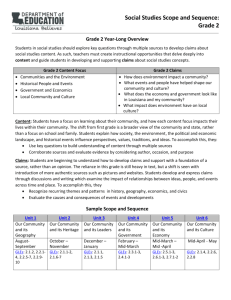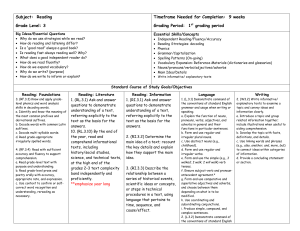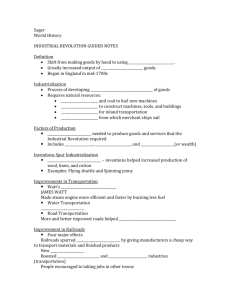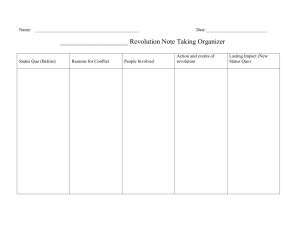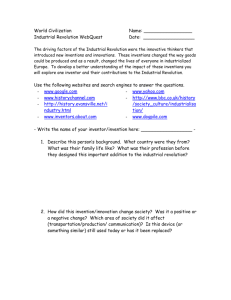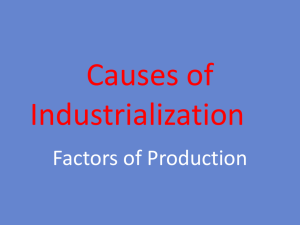Social Studies Sample Scope and Sequence - Grade 4
advertisement
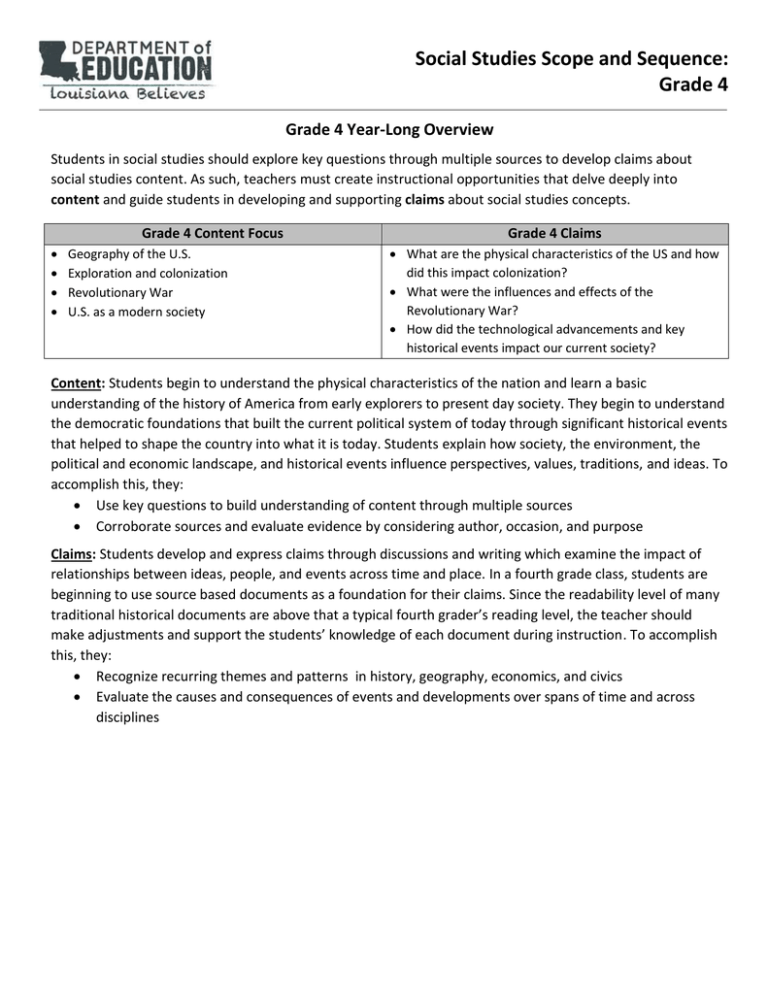
Social Studies Scope and Sequence: Grade 4 Grade 4 Year-Long Overview Students in social studies should explore key questions through multiple sources to develop claims about social studies content. As such, teachers must create instructional opportunities that delve deeply into content and guide students in developing and supporting claims about social studies concepts. Grade 4 Content Focus Geography of the U.S. Exploration and colonization Revolutionary War U.S. as a modern society Grade 4 Claims What are the physical characteristics of the US and how did this impact colonization? What were the influences and effects of the Revolutionary War? How did the technological advancements and key historical events impact our current society? Content: Students begin to understand the physical characteristics of the nation and learn a basic understanding of the history of America from early explorers to present day society. They begin to understand the democratic foundations that built the current political system of today through significant historical events that helped to shape the country into what it is today. Students explain how society, the environment, the political and economic landscape, and historical events influence perspectives, values, traditions, and ideas. To accomplish this, they: Use key questions to build understanding of content through multiple sources Corroborate sources and evaluate evidence by considering author, occasion, and purpose Claims: Students develop and express claims through discussions and writing which examine the impact of relationships between ideas, people, and events across time and place. In a fourth grade class, students are beginning to use source based documents as a foundation for their claims. Since the readability level of many traditional historical documents are above that a typical fourth grader’s reading level, the teacher should make adjustments and support the students’ knowledge of each document during instruction. To accomplish this, they: Recognize recurring themes and patterns in history, geography, economics, and civics Evaluate the causes and consequences of events and developments over spans of time and across disciplines Social Studies Scope and Sequence: Grade 4 Sample Scope and Sequence Unit 1 Regional Geography of the United States August-MidSeptember GLEs1: 4.1.1-7, 4.4.1-7, 4.5.1-3, 4.6.1-2 1 Unit 2 Unit 3 Unit 4 Unit 5 Unit 6 Exploration and Colonization Becoming the United States Our Nation Grows Innovation and Change Modern America Mid-SeptemberMid-October GLEs: 4.1.1-7, 4.2.2, 4.9.2-3, 4.9.7 Mid-OctoberDecember GLEs: 4.1.1-7, 4.2.1-2, 4.2.4, 4.7.1-4, 4.8.1-4, 4.9.5-6 January-February March-Mid-April Mid-April-May GLEs: 4.1.1-7, 4.2.1-3 GLEs: 4.1.1-7, 4.2.2, 4.2.5, 4.3.1, 4.9.2, 4.9.4, 4.9.6-7, 4.9.10 GLEs: 4.1.1-7, 4.2.2, 4.3.1, 4.8.4, 4.9.1, 4.9.4, 4.9.8-9 Note: The GLEs apply to every unit as they describe the historical thinking skills students should use to learn and demonstrate understanding of social studies content. Social Studies Scope and Sequence: Grade 4 Unit 1: Regional Geography of the United States (August–Mid-September) Unit overview: In this unit students explore the variety of landforms and geographic make-up of the United States, and how each region has influenced economic development. This sets the stage for the unit to follow where students explore the early days of exploration and colonization through various geographic regions. Topic and Days Content and Claims Landforms 10 days Regions 10 days Possible Sources How can we define the location of Possible Sources Outline Map with Landforms, National Geographic a place? (4.4.1-4.4.7) How are the characteristics of each Types of Land, Harcourt School region similar and different? Outline Maps, Education Place (4.5.1 ) Landform Regions of the United States, Eduplace Physical Map of the United States, FEMA United States Landforms, Mr. Nussbaum Major Landforms, World Atlas How do the physical characteristics Possible Sources United States Regions, National Geographic of each region shape its economic development? (4.5.2) Let’s Explore the Pacific Northwest, Kathleen Connors How do the physical characteristics Let’s Explore the Great Basin, Kathleen Connors of each region influence human Let’s Explore the Midwest, Kathleen Connors settlement? (4.5.3) Let’s Explore the Northeast, Kathleen Connors How do natural processes and Let’s Explore the Southwest, Kathleen Connors human processes impact the land States and Regions, Harcourt School and water around them? (4.6.1-2) Regions of the U.S., Scholastic Railroad Maps 1828-1900, Library of Congress Northeast, Discovery Education West, Discovery Education South, Discovery Education Midwest, Discovery Education Interactive Maps, Eduplace Social Studies Scope and Sequence: Grade 4 Unit 2: Exploration and Colonization (Mid- September–Mid-October) Unit overview: In this unit students explore early settlers to the New World and learn about the early colonies established. This sets the stage for the unit to follow where students explore the democratic ideals that pushed the nation into the Revolutionary War. Topic and Days Content and Claims Early Explorers 10 days Early Settlers 10 days Sample Task and Possible Sources How did early explorers lead to the Possible Sources Early Voyages of Exploration 1492-1609, Prentice Hall discovery and settlement of the early colonies? (4.2.2) Exploration of North America, 1492-1700, Eduplace What were the risks involved with Age of Exploration: Life on the Seas, History.com exploration and early settlement? Exploring the Americas (Chester the Crab’s Comics (4.9.3) with Content Series), Bentley Boyd Sample Task What were the motivations for exploration and early settlement? Louisiana Instructional Task (4.9.2-3, 4.9.7) o Growth of NY during Colonial Period Possible Sources You Wouldn’t Want to Be an American Colonist!: A Settlement You’d Rather Not Start, Jacqueline Morley Observations Gathered out of a Discourse of the Plantation of the Southern Colony, George Percy The New Americans: Colonial Times: 1620-1689 (The American Story), Betsy Maestro Early American Frontier, 1774, Archiving Early America Social Studies Scope and Sequence: Grade 4 Unit 3: Becoming the United States (Mid-October–December) Unit overview: In this unit students explore early the early origins of how the United States came to be and the role of the founding father played in developing our democratic society. This sets the stage for the unit to follow where students examine westward expansion and the idea of manifest destiny. Note: This content could be taught in conjunction with the If You Lived at the Time of the American Revolution (Lessons 1 -5, 7, 9, and 12) from the English Language Arts Guidebook for Grade 4. Topic and Days Content and Claims Founding Fathers 10 days How did the founding fathers impact the formation of the United States? (4.2.2) How did explorers and pioneers impact the growth of the United States? (4.2.1-2) American Government 15 days Citizenship in America 10 days How have key events led to the expansion of democracy? (4.2.4) How have our country’s major democratic documents shaped our government’s structure and functions? (4.7.2) What are the purposes and necessities of a government? (4.7.3) What are some of the significant changes made to the constitution over time, and what impacts did they have on our country? (4.7.1, 4.7.3) How are the three branches of government different in both structure and function? (4.7.4) What are the key requirements to become a United States citizen? (4.8.1) What are the differences between a citizen’s rights, responsibilities, Possible Sources Possible Sources Illustrated Timeline of US Presidents, Mary Englar “Thomas Jefferson,” ReadWorks Who was Thomas Jefferson?, Dennis B. Fradin “George Washington,” ReadWorks “American Government- James Madison,” ReadWorks Possible Sources “Colonization & Revolutionary War,” ReadWorks You Wouldn’t Want to Be at the Boston Tea Party!: Wharf Water Tea You’d Rather Not Drink, Peter Cook “Paul Revere’s Ride,” ReadWorks Texts from ELA Guidebook Unit, Grade 4: o Liberty!: How the Revolutionary War Began, Lucille Recht Penner o And Then What Happened, Paul Revere? Jean Fritz o Those Rebels, John and Tom, Barbara Kerley o . . . If You Lived at the Time of the American Revolution, Kay Moore o George vs. George: The American Revolution as Seen from Both Sides, Rosalyn Schanzer Possible Sources U.S. Constitution Interactive, Mr. Nussbaum Shhh! We’re Writing the Constitution!, Jean Fritz If You Were There When They Signed the Constitution, Elizabeth Levy The Constitution, Suzanne LeVert “American Government- Branches of Government,” ReadWorks Social Studies Scope and Sequence: Grade 4 and duties? (4.8.2) What elements of a democracy are dependent upon good citizenship? (4.8.3-4) How does a government provide goods and services? (4.9.5, 4.9.6) “American Government - Preamble to the United States Constitution,” ReadWorks Requirements for Citizenship, U.S. Immigration Services “American Government - Bill of Rights Part I and II,” ReadWorks The New Nation, Joy Hakim Our National Symbols, Linda Carlson Johnson Social Studies Scope and Sequence: Grade 4 Unit 4: Our Nation Grows (January–February) Unit overview: In this unit students explore early the early origins of how the United States grew in size through the idea of manifest destiny and the impact technology made on this growth. This sets the stage for the unit to follow where students explore more technological changes and the effect these inventions had on the economy and workforce in the United States. Topic and Days Content and Claims Sample Task and Possible Sources Westward Expansion and Manifest Destiny 15 days How have our leaders impacted the growth of the United States? (4.2.2) How did explorers and pioneers impact the growth of the United States? (4.2.1-2) How have migration patterns impacted the boundaries of the U.S.? (4.2.3) Louisiana Purchase 10 days How have our leaders impacted the growth of the United States? (4.2.2) How did explorers and pioneers impact the growth of the United States? (4.2.1-2) How have migration patterns impacted the boundaries of the U.S.? (4.2.3) Possible Sources Growth of a Nation, Animated Atlas Westward Ho!, Lucille Recht Penner Into the West, Terry Collins PBS “The West” from pre-1500 to 1979 Artifacts and Images of the Era of Manifest Destiny, Authentic History Center Boomtowns of the West, Bobbie Kalman You Wouldn’t Want to Be a Pony Express Rider!: A Dusty, Thankless Job You’d Rather Not Do, Tom Ratliff You Wouldn’t Want to Live in a Wild West Town!: Dust You’d Rather Not Settle, Peter Hicks You Wouldn’t Want to Be an American Pioneer!: A Wilderness You’d Rather Not Tame, Jacqueline Morley California Gold Rush, Shirley Jordan What was the Gold Rush?, Joan Holub “Panning for History,” ReadWorks Possible Sources The Louisiana Purchase, Learning Liftoff Thomas Jefferson and the Louisiana Purchase, Emily Raabe Building an Empire: The Louisiana Purchase, Linda Thompson Louisiana Purchase map, Mr. Nussbaum Lewis and Clark, National Geographic Lewis and Clark, U.S. Mint “American Explorers,” Center for Urban Education You Wouldn’t Want to Explore with Lewis and Clark!: An Epic Journey You’d Rather Not Make, Jacqueline Morley Social Studies Scope and Sequence: Grade 4 Transcontinental Railroad 10 days How have our leaders impacted the growth of the United States? (4.2.2) How did explorers and pioneers impact the growth of the United States? (4.2.1-2) How have migration patterns impacted the boundaries of the U.S.? (4.2.3) Sample Task Louisiana Instructional Task o The Transcontinental Railroad Possible Sources Building the Transcontinental Railroad, Steven Offinski Transcontinental Railroad, Alan Pierce Transcontinental Railroad, John Perritano The Great Railroad Race – Diary of Libby West, Kristiana Gregory You Wouldn’t Want to Work on the Railroad!: A Track You’d Rather Not Go Down, Ian Graham Social Studies Scope and Sequence: Grade 4 Unit 5: Innovation and Change (March–Mid-April) Unit overview: In this unit students explore causes of mass immigration and inventions that shaped the immigration patterns across the landscape. This sets the stage for the unit to follow where students explore how modern American came to be through influential leaders in the Civil Rights Movement and the impact of a rapidly advancing technological society. Topic and Days Content and Claims Immigration 10 days How have immigration patterns impacted the culture of the U.S.? (4.2.2, 4.2.5) Innovations 10 days How do new inventions and processes affect people and the country? (4.3.1) Industrial Revolution How did increased manufacturing lead to rapid urbanization? (4.9.2) How did industry create demands for increased skill and knowledge? (4.9.10) How did industrialization impact consumers? (4.9.4, 4.9.6-7) 10 days Sample Tasks and Possible Sources Possible Sources “Immigration,” ReadWorks The Irish Potato Famine: Irish Immigrants Come to America (1845-1850), Jeremy Thornton You Wouldn’t Want to Sail on an Irish Famine Ship!: A Trip Across the Atlantic You’d Rather Not Make, Jim Pipe Religious Intolerance: Jewish Immigrants Come to America (1881-1914), Jeremy Thornton If Your Name was Changed at Ellis Island, Ellen Levine Ellis Island, R. Conrad Stein Possible Sources Robert Fulton, Steven Roberts Timeless Thomas: How Thomas Edison Changed our Lives, Gene Barreta Henry Ford, Mike Venezia “Henry Ford: A Giant of a Man,” PassageBank Famous Inventors, Biography.Com (Passages and media links Possible Sources America Enters the Industrial Revolution, Susan Hamer The Industrial Revolution, Melissa McDaniel (Scholastic) Industrial Revolution for Kids, Cheryl Mullenbach Industrial Revolution, Debra Housel Industrial Revolution, Susan Hamen Industrial Revolution, Alan Pierce “The Industrial Revolution,” ReadWorks Social Studies Scope and Sequence: Grade 4 Unit 6: Modern America (Mid-April–May) Unit overview: In this unit students explore how modern American came to be through influential leaders in the Civil Rights Movement and the impact of a rapidly advancing technological society. Topic and Days Content and Claims Civil Rights Movement 10 days How have our leaders impacted the United States? (4.2.2) How did civil rights leaders work to solve a current issue? (4.8.4) Technological Advances 10 days How do new technologies affect people and the country? (4.3.1) Modern Economy 10 days How do people plan their finances to thrive in our modern economy? (4.9.1, 4.9.4, 4.9.8-9) Sample Tasks and Possible Sources Possible Sources “Dr. Martin Luther King, Jr.,” Center for Urban Education Elizabeth Leads the Way: Elizabeth Cady Stanton and the Right to Vote, Tanya Lee Stone 1913 Women’s Suffrage Parade, The Atlantic Possible Sources @ Home and City, NASA 15 Ways Phones Evolved, BGR Illuminating Photography, YouTube Inventions in Science and Technology: Ideas that Changed the World, Ian Graham Inventions in Communication: Ideas that Changed the World, Ian Graham Great Discoveries and Inventions that Improved Human Health, Antonio Casanellas Sample Task Louisiana Instructional Task o Economics Case Study: Janesville, WI Possible Sources Managing Money: Spending and Saving, PBS Kids Financial Fables, Federal Reserve Hands on Banking, Wells Fargo 2011 Social Studies Grade-Level Expectations: Grade 4 History Standard 1 – Chronological and Historical Thinking Students use chronological sequencing of key events and symbols to understand the movement of people and the expansion of boundaries in the United States. 4.1.1 Construct timelines of historical events 4.1.2 Use timelines to explain how changes over time have caused movement of people or expansion of boundaries in the United States 4.1.3 Use appropriate vocabulary of time 4.1.4 Produce clear and coherent writing to: compare and contrast past and present viewpoints on a given historical topic conduct simple research summarize actions/events and explain significance differentiate between the 5 regions of the United States 4.1.5 Explain the historical significance of U.S. political symbols 4.1.6 Define and distinguish between primary and secondary sources 4.1.7 Summarize primary resources and explain their historical importance Standard 2 – People and Events Students explain the historical significance of key people and events in order to examine the expansion of the boundaries and development of democracy in the United States. 4.2.1 Explain how early explorations affected the expansion of boundaries and development in the United States 4.2.2 Cite evidence to support the key contributions and influence of people in the history of the United States 4.2.3 Explain the voluntary migration of people and its significance in the development of the boundaries of the United States 4.2.4 Draw conclusions about the relationship of significant events in the history of the United States to the expansion of democracy in the United States 4.2.5 Use the concepts “melting pot,” “salad bowl,” and “cultural mosaic” to explain the impact of immigration on population growth and diversity in the United States Standard 3 – People and Events Students examine the impact of scientific and technological advances on the development of the United States. 4.3.1 Explain how inventions and new processes affected the lives of people, migration, and the economy of regions of the United States 2011 Social Studies Grade-Level Expectations: Grade 4 Geography Standard 4 – Maps and Globes Students use map skills to construct and interpret geographical representations of the world. 4.4.1 Locate and label continents, oceans, the poles, hemispheres, and key parallels and meridians on a map and globe 4.4.2 Locate and label on a map the major physical features of each of the five regions of the United States and summarize how they affect the climate, economy, and population of each region 4.4.3 Identify the states of each of the five regions of the United States 4.4.4 Measure approximate distance on a map using scale to the nearest hundredth mile 4.4.5 Determine the approximate longitude and latitude coordinates of various locations in the United States 4.4.6 Interpret various types of maps using a key/legend, compass rose including cardinal and intermediate directions, latitude/longitude, and scale 4.4.7 Use mental mapping to construct a map of the United States regions and the world to include map elements (title, compass rose, legend/key, scale) Standard 5 – People and Land Students compare and contrast the physical and human characteristics of each United States region in order to understand their similarities and differences. 4.5.1 Compare and contrast the distinguishing physical characteristics of the five regions of the United States 4.5.2 Analyze how physical characteristics of a region shape its economic development 4.5.3 Identify and explain how the physical characteristics of a region influenced human settlement Standard 6 – Environment Students describe how natural and man-made processes change the geography of regions in the United States. 4.6.1 Illustrate how natural processes have created and/or changed the physical characteristics of places in the United States 4.6.2 Describe the human impact on the land and bodies of water of the five regions of the United States Civics Standard 7 – Government and Political Systems Students explain the structure and purposes of government and the foundations of the United States’ democratic system using primary and secondary sources. 2011 Social Studies Grade-Level Expectations: Grade 4 4.7.1 Identify and summarize significant changes that have been made to the United States Constitution through the amendment process 4.7.2 Explain the significance of key ideas contained in the Declaration of Independence, the United States Constitution, and the Bill of Rights 4.7.3 Identify and analyze the basic purposes and necessity of government as identified in the Preamble to the United States Constitution 4.7.4 Differentiate between the structure and function of the three branches of federal government Standard 8 – Role of Citizen Students examine the rights, responsibilities, and duties of a United States citizen in order to understand how individuals contribute to the democratic system of government. 4.8.1 Identify the key requirements to become a United States citizen 4.8.2 Differentiate between citizens’ rights, responsibilities, and duties 4.8.3 Describe the qualities of a good citizen and how good citizenship contributes to the United States’ democracy 4.8.4 Explain how good citizenship can solve a current issue Economics Standard 9 – Fundamental Economic Concepts Students demonstrate knowledge of economic concepts. 4.9.1 Develop a logical argument to support the choice of a particular want after all needs are met 4.9.2 Identify examples of human, natural, and capital resources and explain how these resources are used to produce goods and provide services 4.9.3 Define the terms profit and risk and explain how they relate to each other 4.9.4 Investigate the relationship between supply, demand, and price 4.9.5 Describe how government pays for goods and services through taxes and fees 4.9.6 Summarize the roles of households, businesses, jobs, banks, and governments in the economy 4.9.7 Explain why individuals and businesses engage in barter and trade 4.9.8 Differentiate between money (currency), checks, debit cards, and credit cards and identify advantages and disadvantages of each type of monetary exchange 4.9.9 Define budget, income, and expense and explain the benefits of making and following a budget 4.9.10 Analyze the benefits of increasing skills

